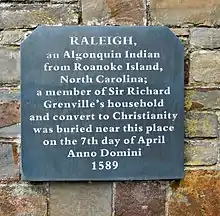Raleigh (Native American)
Raleigh (died 2 April 1589) was a Native American who was among the first to be brought to England from America in the late 16th-century. Living in the home of Sir Richard Grenville in Bideford, he was the first Native American on record to have a Christian conversion and an English burial site preceding Pocahontas.

Sir Richard Grenville captured the Roanoke Island Native American Raleigh (named for Grenville's cousin Sir Walter Raleigh) following a skirmish in 1586 and brought him to Bideford. He may have been one of three Native Americans who were captured, remaining in captivity after the two others escaped.[1][2] Described as a "Wynganditoian", he had his baptism at Saint Mary's Church in Bideford on 27 March 1588.[3]

Sir Walter Raleigh later corrected the place name Raleigh is said to have originated from, stating that "[W]hen some of my people asked the name of that Countrie one of the Savages answered Wingandacon, which is as much to say, as, you weare good clothes, or gay clothes." The mistake may have been corrected by Manteo.[1] It is not likely that Raleigh was a member of the friendly Hatteras Indians led by Manteo but was probably a member of a tribe allied to Wanchese, who had been involved in several skirmishes with the English previously on Roanoke.[4][5]
Little is known of Raleigh or why Grenville brought him to Bideford. Grenville was planning another voyage to America and it could have been his intention to take Raleigh back to Roanoke where his local knowledge and native language would have been useful.[6] He died from influenza in Grenville's house on 2 April 1589, his interment in the churchyard of Saint Mary's Church in Bideford taking place five days later.[4] Raleigh was the first Native American to legally have a Christian conversion and an English resting place.[4][7]
A record in the Bodleian Library at Oxford dated 1792 states that Raleigh was not buried in the church crypt, but in the Churchyard. As this record pre-dates the Victorian rebuilding of St Mary's church in the mid-1860s it is probable that his now unmarked grave lies somewhere there still.[4][6]
References
- Alden T. Vaughan, Transatlantic Encounters: American Indians in Britain, 1500-1776, Cambridge University Press (2006) - Google Books pg 26
- Karen Ordahl Kupperman, Roanoke, the Abandoned Colony, Volume 2, Rowman & Littlefield Publishers, Inc., (1984) - Google Books pg 94
- David Beers Quinn, The Roanoke Voyages, 1584-1590: Documents to illustrate the English Voyages to North America under the Patent granted to Walter Raleigh in 1584, Volume 1, Ashgate (1952) - Google Books pg 495
- "Raleigh, a Wynganditoian | Native Heritage Project". nativeheritageproject.com. Retrieved 19 August 2018.
- Alden T. Vaughan, Sir Walter Ralegh's Indian Interpreters, 1584-1618, The William and Mary Quarterly, Vol. 59, No. 2 (Apr., 2002), pp. 341-376
- David Howell, The Bideford Heritage Trail, Pub: Bideford 500 Heritage Group (2011) pg 8
- "Lost Colony Research Group". rootsweb.ancestry.com. Retrieved 19 August 2018.